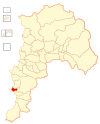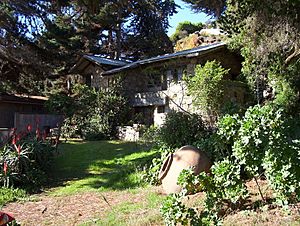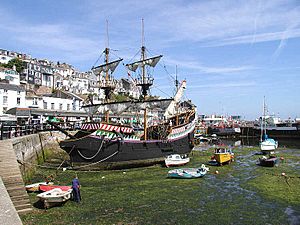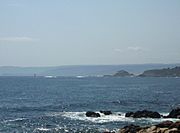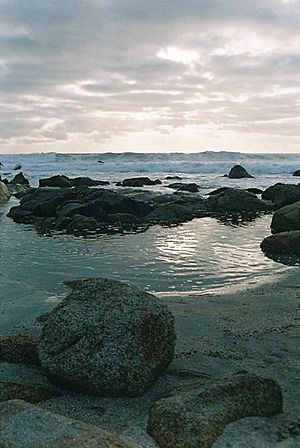El Quisco facts for kids
Quick facts for kids
El Quisco
|
|||||
|---|---|---|---|---|---|
|
|||||
| Country | Chile | ||||
| Region | Valparaíso | ||||
| Province | San Antonio | ||||
| Government | |||||
| • Type | Municipality | ||||
| Area | |||||
| • Total | 50.7 km2 (19.6 sq mi) | ||||
| Elevation | 13 m (43 ft) | ||||
| Population
(2012 Census)
|
|||||
| • Total | 11,329 | ||||
| • Density | 223.45/km2 (578.7/sq mi) | ||||
| • Urban | 8,931 | ||||
| • Rural | 536 | ||||
| Sex | |||||
| • Men | 4,815 | ||||
| • Women | 4,652 | ||||
| Time zone | UTC-4 (CLT) | ||||
| • Summer (DST) | UTC-3 (CLST) | ||||
El Quisco is a city and a "commune" (a type of local government area) in Chile. It is located in the San Antonio Province within the Valparaíso Region. This city sits on Chile's central coast and is a popular spot for people from Santiago to visit in the summer.
El Quisco is part of the "Coast of Poets." This special area is named after four famous Chilean poets: Pablo Neruda, Vicente Huidobro, Violeta Parra, and Nicanor Parra. You can even visit La Casa de Isla Negra in El Quisco. This was once the home of the poet Pablo Neruda and is now a museum where he is buried.
Contents
What Does "El Quisco" Mean?
The name "quisco" comes from a type of cactus called Echinopsis chiloensis. This cactus grows naturally along the central coast of Chile. The word itself comes from khishka in the Quechua language, which means "spine."
El Quisco's Long History
People have lived in the El Quisco area for a very long time. Scientists have found important old items from different periods, showing that ancient cultures thrived here.
Ancient Cultures of El Quisco
El Quisco was once home to several ancient groups, including the Bato and Llolleo cultures. These groups lived here around the same time as the El Molle culture further north.
The Bato culture started between 400 and 300 BC. They used a special metal or stone rod called a tembetá that they wore in their lower lips. They also used mortars (stones) to grind plants and minerals. Evidence of the Bato culture has been found in areas like Trebulco. This culture was at its strongest between 400 and 500 AD.
The El Molle culture arrived in Chile around 300 AD. They came from places like Brazil, Argentina, and Peru. Their first settlements were inland, in a place called El Molle. They mixed with the people already living there. The El Molle culture later led to the Diaguita culture.
The Aconcagua culture also lived along the coast, in areas near modern-day El Quisco. Their pottery, often called Aconcagua Salmon Type, was orange with black designs. They often decorated their bowls with a three-armed swirl pattern.
The Picunche People
More recently, the Picunche people lived between the Choapa and Itata rivers. They were farmers who grew crops like gourds, corn, beans, and chili peppers. They also raised animals like llamas and guanacos for food and wool.
The Picunche lived in small, peaceful villages of about 300 people. Their homes were made of mud with roofs of totora plants. About 30 family members lived in each house. Men were in charge, with the father as the main leader.
The Inca Empire's Influence
The El Quisco area became part of the Inca Empire, specifically a region called Qullasuyu. The Inca leaders wanted to make sure their customs were followed. So, they moved many families called mitimaes from other parts of the empire to this area. These mitimaes were farmers and skilled workers.
They founded new villages with names that reminded them of their original homes, like Limache. Inca soldiers wore clothes made from a plant called Pulla Pulla. This plant's flowers were thought to predict if the farming year would be good.
Around 1430, the Inca leader Túpac Inca Yupanqui expanded the empire. An Inca noble named Ilabe settled in the Llollehue valley. He founded a colony and a pucará (a type of fort). He also appointed kurakas (governors) to manage the area. These leaders helped set up the Inca way of life, including how land was used and public projects like roads.
Spanish Arrival and Pirates
The Spanish first arrived in the El Quisco area around 1570. A Spanish family, the Alonso de Córdobas, took control. Before this, the area was called Huallilemu, meaning "forest of oakwood," and later El Totoral because of its many totora plants.
Pirates on the Coast
After 1578, El Quisco became a secret hiding spot for pirates! Famous English pirates like Francis Drake, Thomas Cavendish, and Richard Hawkins used these bays. Dutch pirates like Oliver Van Noort also visited. Francis Drake might have even anchored his ship, the Golden Hind, in the bay in December 1578. He traveled with two Japanese explorers, Christopher and Cosmas, who were the first Japanese people to sail around the world.
Towards the end of the time when Spain ruled Chile, many foreign ships were illegally trading along the Chilean coast. These ships often had the support of local people who were born in Chile but had European families. These locals disliked how the Spanish authorities tried to control everything.
El Quisco Today
The commune of El Quisco was officially created on August 30, 1956. This happened under the presidency of Carlos Ibáñez del Campo.
El Quisco's Population
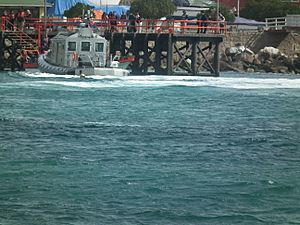
According to a 2002 count, El Quisco covers about 50.7 square kilometers (about 19.6 square miles). It had 9,467 people living there at that time. Most of these people (8,931) lived in urban areas, while 536 lived in rural areas. The population grew quite a bit between 1992 and 2002, by about 55.3%.
How El Quisco is Governed
El Quisco is a "commune," which means it's a local administrative area in Chile. It's managed by a "municipal council." This council is led by an "alcalde" (mayor), who is chosen directly by the people every four years. The alcalde from 2008 to 2012 was Natalia Carrasco Pizarro.
The municipal council members during that time included:
- Cristofer Ceballos Lira
- Juan Andrés Berrios Olmedo
- José Moraga Lira
- Maria Magdalena Bianchi Berroeta
- Guillermo Romo Díaz
- Guillermo Vidal Devia
El Quisco is also part of larger political areas. Its people are represented in the Chamber of Deputies (like a house of representatives) and the Senate (another part of the national government).
Different Parts of El Quisco
El Quisco has four main areas, each with its own unique geography and culture:
- El Quisco proper (the main town)
- Punta de Tralca
- Isla Negra
- El Totoral
Fun Things to Do in El Quisco
The El Quisco area is a favorite place for tourists in central Chile. It's easy to get to from Santiago. There are many places to stay, like homes for rent and hotels. You can also find lots of restaurants and inns that serve delicious typical Chilean food. If you love water, you can enjoy marine sports like scuba diving and swimming.
Famous People from El Quisco
Many well-known people have lived in or had strong connections to El Quisco:
- Pablo Neruda: A famous poet who won the Nobel Prize in Literature.
- Violeta Parra: A well-known singer and composer. She spent a lot of time in Isla Negra, where she created some of her famous songs.
- Enrique Silva Cimma: A former foreign minister of Chile.
- Patricio Tombolini: A former vice-minister and political leader.
- Clara Solovera: A folklorist who lived from 1909 to 1992.
- René Ríos Boettiger: A Chilean cartoonist who created the popular character Condorito.
- Jose Perotti: A winner of the National Prize of Art.
- Camilo Mori: A painter who designed the official seal for the city of El Quisco.
- Sonia Tschorne: A vice-minister for Housing and Urbanism.
- Osvaldo Puccio: A politician.
- Jose Michael Puccio: A surgeon who worked for the Presidency of Chile.
- Mario López Ibáñez: A physician.
- Roberto Marín Vivado: A doctor with a long career, known for his love of food.
See also
 In Spanish: El Quisco para niños
In Spanish: El Quisco para niños



